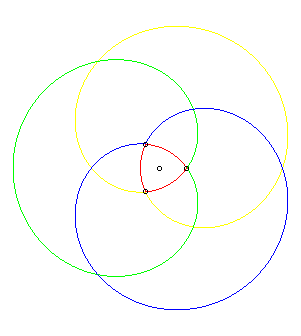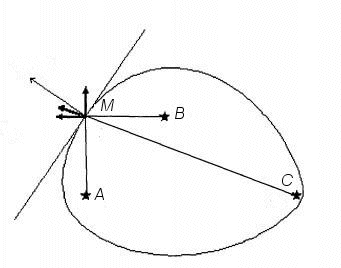Multipolar equation:
The case n = 1 gives, of course, the circles.
The case n = 2 gives the classic ellipses. More precisely,
| next curve | previous curve | 2D curves | 3D curves | surfaces | fractals | polyhedra |
MULTIFOCAL ELLIPSE or EGGLIPSE
| Curve studied by Tschirnhaus in 1686, and Maxwell in
1846.
Other names: multiellipse, polyellipse, hyperellipse, Tschirnhaus egg. Sites : English Wikipedia (N-ellipses) English Wikipedia (Generalized conic) French Wikipedia (point de Fermat-Weber) http://www.aimath.org/WWN/convexalggeom/AIM.pdf On the Approximation of Convex, Closed Plane Curves by Multifocal Ellipses text by Maxwell article on the algebraic side on the triellipses http://www.journaloftheoretics.com/Articles/6-6/MFCC.pdf?q=foci on the Fermat point Gyula Sz.-Nagy (June 1950). "Tschirnhaus'sche Eiflachen und EiKurven". Acta Mathematica Academiae Scientiarum Hungarica 1 (2): 167–181. |
The multifocal ellipses, with n foci, are the loci
of the points of the plane for which the sum of the distances to n
points is constant.
Multipolar equation: .
The case n = 1 gives, of course, the circles.
The case n = 2 gives the classic ellipses. More
precisely,
is, at the minimum, AB and when
,
gives the ellipse with foci A and B and major axis a,
reduced to the segment line [AB] when a =AB.
| For n = 3, the minimal value of If the angles of the triangle are acute, then the Fermat point is defined by the fact that, from it, the sides are seen under 120° angles (example opposite). If one of the angles is greater than or equal to 120°, then the Fermat point is the corresponding vertex; in the flat case with distinct vertices, the Fermat point is the middle vertex. If two points coincide, they also coincide with the Fermat point, and we get a Cartesian oval. The minimal value of the sum is As we can see opposite, the triellipses have a tangent at all point except when they pass by the vertices of the triangle. |
 |
| Generalisation of the gardener's ellipse-tracing method for a triellipse, proposed by Maxwell. |
|
| Opposite, the case of an equilateral triangle. |
 |
| Since the product For example, the equation of the algebraic curve corresponding
to the triellipse passing by the vertices of the previous equilateral triangle,
represented opposite, is:
In the other cases, the triellipse is only an oval connected component of the algebraic curve, that can contain at most four of them. |
 |
| As for the ellipse, the tangent to the ellipse is constructed
perpendicularly to the vector |
 |
| For The n-ellipse is included in an algebraic curve of degree Opposite, the quadriellipse passing by the vertices of a square, and the associated algebraic curve, of degree 16 – 6 = 10. |
 |
Compare to the Cassinian
curves, with equation .
| Animation of the complete triellipse associated to an
equilateral triangle, starting from a = 0.
For large values of a, the curve |
 |
| next curve | previous curve | 2D curves | 3D curves | surfaces | fractals | polyhedra |
© Robert FERRÉOL 2017